The Acrylic Resin Market is estimated to be valued at USD 24.6 billion in 2025 and is projected to reach USD 42.4 billion by 2035, registering a compound annual growth rate (CAGR) of 5.5% over the forecast period.
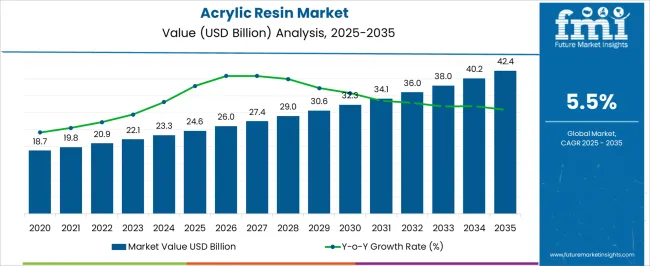
| Metric | Value |
|---|---|
| Acrylic Resin Market Estimated Value in (2025 E) | USD 24.6 billion |
| Acrylic Resin Market Forecast Value in (2035 F) | USD 42.4 billion |
| Forecast CAGR (2025 to 2035) | 5.5% |
The acrylic resin market is expanding strongly, driven by increasing demand across coatings, adhesives, and construction industries. Acrylic resins are valued for their excellent adhesion, weather resistance, and versatility, making them integral to diverse industrial and consumer applications.
Rising investment in building infrastructure, coupled with strong automotive and packaging sectors, has supported consistent market growth. The adoption of eco-friendly, water-based acrylic formulations has further accelerated demand, aligning with global environmental regulations and sustainable product trends.
Market dynamics are also shaped by innovations in resin chemistry that improve performance characteristics, such as UV stability and durability, broadening end-use applications. With ongoing expansion in industrial production and infrastructure development, the acrylic resin market is expected to remain a key component in the global polymers and specialty chemicals industry.
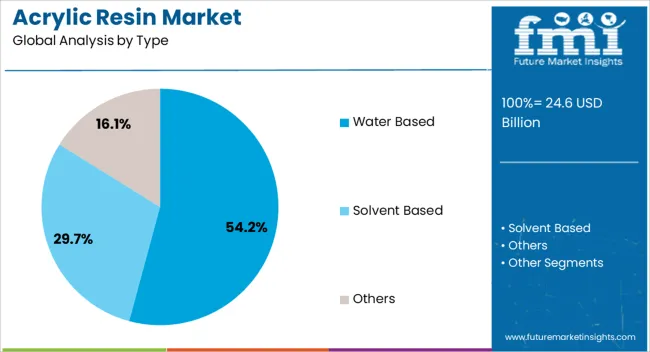
The water based segment leads the type category with approximately 54.20% share, attributed to its environmental benefits and compliance with stringent VOC emission regulations. Water based acrylic resins are increasingly used in paints, coatings, and adhesives due to their low toxicity, reduced odor, and ease of application.
The segment benefits from strong adoption in markets transitioning toward eco-friendly solutions, particularly in Europe and North America. Continuous improvements in performance properties, such as enhanced adhesion and faster drying, have expanded usage across multiple industries.
With rising demand for sustainable and safer resin alternatives, the water based segment is projected to maintain its leadership in the coming years.
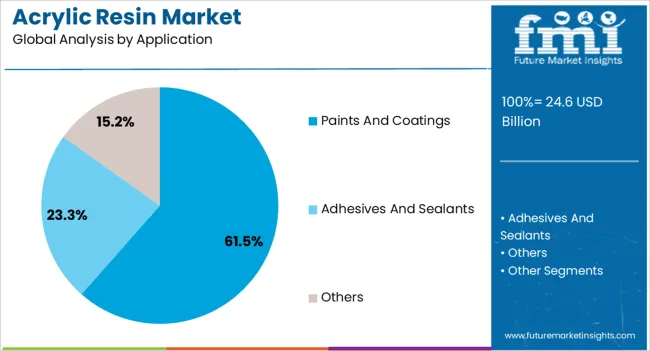
The paints and coatings segment dominates the application category with approximately 61.50% share, reflecting the extensive use of acrylic resins in protective and decorative applications. The segment benefits from acrylic resins’ superior durability, UV resistance, and gloss retention, making them suitable for automotive, construction, and industrial coatings.
Rising urbanization and infrastructure spending have reinforced demand for decorative paints, while industrial growth has fueled the adoption of protective coatings. The trend toward waterborne formulations has further supported acrylic resins, positioning them as the preferred binder in modern coating technologies.
With consistent investment in infrastructure and industrial production, the paints and coatings segment is expected to remain the largest application area.
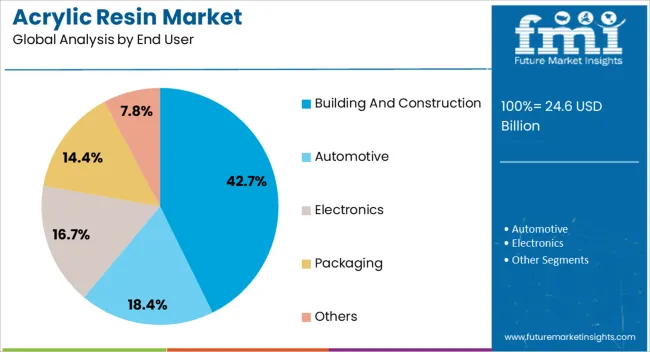
The building and construction segment accounts for approximately 42.70% share of the end-user category, underscoring its importance in driving acrylic resin consumption. Acrylic resins are used extensively in architectural coatings, adhesives, sealants, and waterproofing solutions, ensuring structural durability and aesthetic appeal.
Rapid urbanization, population growth, and government-backed housing initiatives have increased construction activity worldwide, directly boosting resin demand. The segment also benefits from the rising trend toward sustainable construction materials, where water-based acrylic resins play a pivotal role.
With infrastructure expansion continuing across both emerging and developed economies, the building and construction segment is expected to sustain its leadership in the forecast period.
The scope for acrylic resin rose at a 5.6% CAGR between 2020 and 2025. The global market for acrylic resin is anticipated to grow at a moderate CAGR of 6.2% over the forecast period 2025 to 2035.
| Report Attributes | Details |
|---|---|
| Market Value in 2020 | USD 17.3 billion |
| Market Value in 2025 | USD 22.0 billion |
| CAGR from 2020 to 2025 | 6.2% |
The acrylic resin market experienced steady growth during the historical period from 2020 to 2025. Acrylic resins are used in automotive coatings and adhesives. The growth of the automotive industry, driven by factors such as rising disposable income, urbanization, and changing consumer preferences, contributed to increased demand for acrylic resins.
The Asia Pacific region, especially countries like China and India, dominated the market during the historical period, due to rapid industrialization, urbanization, and infrastructure development. The factors contribute to increased demand for acrylic resins in various applications.
Looking ahead to the forecast period from 2025 to 2035, the market is expected to witness significant growth. There has been a growing interest in renewable and bio based acrylic resins as part of the commitment of the industry, to sustainability. Manufacturers exploring eco friendly alternatives are expected to find new opportunities in this segment.
Acrylic resins are used in the manufacturing of medical devices due to their clarity, biocompatibility, and ease of processing. The growth in the healthcare sector and demand for advanced medical equipment and devices can drive the use of acrylic resins.
UV curable acrylic resins have gained popularity due to their fast curing times and low environmental impact. The demand for UV curable coatings in various industries, including electronics, packaging, and automotive, presents growth opportunities for acrylic resin manufacturers.
The below table showcases revenues in terms of the top 5 leading countries, spearheaded by Korea and the United Kingdom. The countries are expected to lead the market through 2035.
| Countries | Forecast CAGRs from 2025 to 2035 |
|---|---|
| The United States | 5.8% |
| The United Kingdom | 6.5% |
| China | 5.9% |
| Japan | 6.0% |
| Korea | 7.9% |
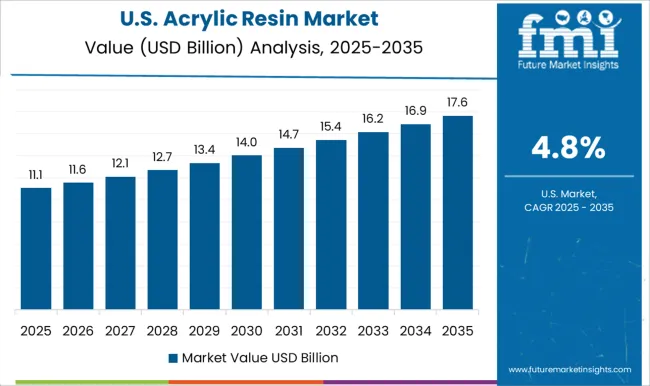
The acrylic resin market in the United States expected to expand at a CAGR of 5.8% through 2035. The construction industry is a major consumer of acrylic resins, particularly in applications such as architectural coatings, adhesives, and sealants. Growth in residential, commercial, and infrastructure construction projects boosts demand for acrylic resins.
The automotive industry uses acrylic resins in coatings and adhesives for vehicles. The growth of this industry positively impacts the demand for acrylic resins, with the automotive sector being a key contributor to the economy of the United States.
The acrylic resin market in the United Kingdom is anticipated to expand at a CAGR of 6.5% through 2035. Renovation and remodeling activities, driven by changing consumer preferences and government incentives, contribute to the demand for paints and coatings. Acrylic resins, being commonly used in architectural coatings, benefit from trends in home improvement.
Acrylic resins are used in the production of consumer goods such as appliances, electronics, and household items. The growth in consumer goods manufacturing activities contributes to the increased consumption of acrylic resins.
Acrylic resin trends in China are taking a turn for the better. A 5.9% CAGR is forecast for the country from 2025 to 2035. Acrylic resins are used in the electronics industry for coatings and encapsulation materials. The growth in this sector positively influences the acrylic resin market, with China being a major hub for electronics manufacturing.
Acrylic resins are used in various packaging materials, coatings, and adhesives. The booming e-commerce industry and increased consumer goods packaging contribute to the growth of the market in China.
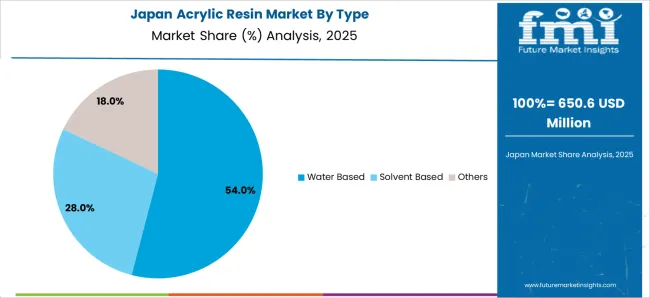
The acrylic resin market in Japan is poised to expand at a CAGR of 6.0% through 2035. Acrylic resins are utilized in various industrial coatings and adhesives. The growth of industrial manufacturing activities in Japan contributes to the increased consumption of acrylic resins in the production of coatings, adhesives, and sealants for industrial use.
Similar to global trends, the adoption of water based acrylic resins over solvent based formulations is driven by environmental concerns and regulations in Japan. The shift towards more sustainable and low VOC coatings supports the growth of water based acrylic resin formulations.
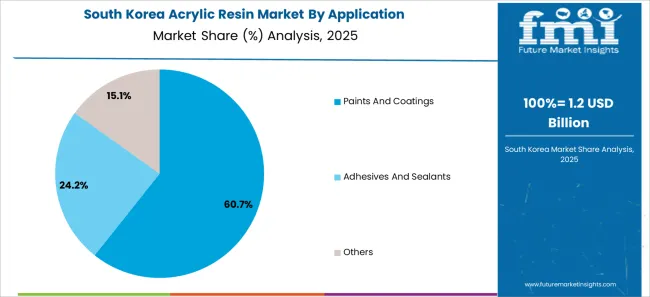
The acrylic resin market in Korea is anticipated to expand at a CAGR of 7.9% through 2035. Korea is a major player in the global shipbuilding industry. Acrylic resins, particularly coatings, are used for corrosion protection and aesthetic finishes in shipbuilding. The growth in the shipbuilding sector can drive the demand for acrylic resins.
Acrylic resins may find applications in coatings and materials used in healthcare facilities and pharmaceutical manufacturing. There can be an increased demand for specialty coatings and adhesives in Korea, as the country invests in advanced healthcare infrastructure.
The below table highlights how water based segment is projected to lead the market in terms of type, and is expected to account for a CAGR of 5.4% through 2035.
Based on application, the paints and coatings segment is expected to account for a CAGR of 5.3% through 2035.
| Category | CAGR in 2035 |
|---|---|
| Water Based | 5.4% |
| Paints and Coatings | 5.3% |
Based on type, the water based segment is expected to continue dominating the acrylic resin market. Water based acrylic resins emit lower levels of VOCs compared to solvent based alternatives. Industries and manufacturers are increasingly choosing water based formulations to comply with regulations and address environmental sustainability goals, as concerns about air quality and environmental impact grow.
Water based acrylic resins are generally considered safer for human health compared to solvent based counterparts. The lower toxicity and reduced flammability of water based formulations contribute to a healthier and safer working environment for operators and end users.
Water based acrylic resins find applications in various industries, including paints and coatings, adhesives, sealants, textiles, and construction. The versatility of water based formulations contributes to their widespread adoption across different sectors.
In terms of application, the paints and coatings segment is expected to continue dominating the acrylic resin market. Acrylic resins offer versatility and formulation flexibility, allowing manufacturers to tailor coatings to meet specific performance requirements. The adaptability makes acrylic resins suitable for a wide range of paints and coatings applications.
Acrylic resin based paints and coatings exhibit excellent weatherability, UV resistance, and durability. The properties make them suitable for outdoor applications, including architectural coatings, automotive coatings, and industrial coatings.
Acrylic resin based coatings typically have fast drying times compared to some other resin types. The attribute contributes to increased efficiency in manufacturing processes, allowing for quicker turnaround times in various applications.
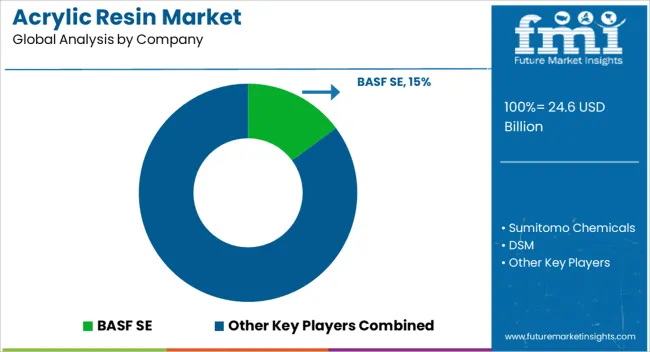
The acrylic resin industry exhibits a dynamic landscape featuring a combination of well established players, regional manufacturers, and emerging companies, all competing to secure their respective market shares. The sector is propelled by industrial expansion, adherence to safety regulations, and the demand for effective vertical access solutions.
Recent Developments
| Attribute | Details |
|---|---|
| Estimated Market Size in 2025 | USD 23.3 billion |
| Projected Market Valuation in 2035 | USD 40.0 billion |
| Value-based CAGR 2025 to 2035 | 5.6% |
| Forecast Period | 2025 to 2035 |
| Historical Data Available for | 2020 to 2025 |
| Market Analysis | Value in USD billion |
| Key Regions Covered | North America; Latin America; Western Europe; Eastern Europe; South Asia and Pacific; East Asia; The Middle East & Africa |
| Key Market Segments Covered | Type, Application, End User, Region |
| Key Countries Profiled | The United States, Canada, Brazil, Mexico, Germany, France, France, Spain, Italy, Russia, Poland, Czech Republic, Romania, India, Bangladesh, Australia, New Zealand, China, Japan, South Korea, GCC countries, South Africa, Israel |
| Key Companies Profiled | BASF SE; Sumitomo Chemicals; DSM; The Dow Company; Showa Denko Materials; Mitsubishi Chemical Holdings; Nippon Shokubai Co. Ltd.; Arkema; DIC Corporation |
The global acrylic resin market is estimated to be valued at USD 24.6 billion in 2025.
The market size for the acrylic resin market is projected to reach USD 42.4 billion by 2035.
The acrylic resin market is expected to grow at a 5.5% CAGR between 2025 and 2035.
The key product types in acrylic resin market are water based, solvent based and others.
In terms of application, paints and coatings segment to command 61.5% share in the acrylic resin market in 2025.






Full Research Suite comprises of:
Market outlook & trends analysis
Interviews & case studies
Strategic recommendations
Vendor profiles & capabilities analysis
5-year forecasts
8 regions and 60+ country-level data splits
Market segment data splits
12 months of continuous data updates
DELIVERED AS:
PDF EXCEL ONLINE
Acrylic Styrene Acrylonitrile (ASA) Resin Market- Growth & Demand 2025 to 2035
Acrylic Paint Market Forecast and Outlook 2025 to 2035
Acrylic Fibre Market Size and Share Forecast Outlook 2025 to 2035
Acrylic Emulsions Market Size and Share Forecast Outlook 2025 to 2035
Acrylic Polymer Market Size and Share Forecast Outlook 2025 to 2035
Acrylic Fine Particle Market Size and Share Forecast Outlook 2025 to 2035
Acrylic Boxes Market Size and Share Forecast Outlook 2025 to 2035
Acrylic Paper Market Size and Share Forecast Outlook 2025 to 2035
Acrylic Pad Market Size and Share Forecast Outlook 2025 to 2035
Acrylic Adhesives Market Growth - Trends & Forecast 2025 to 2035
Acrylic Teeth Market Trends and Assessment for 2025 to 2035
Key Companies & Market Share in the Acrylic Airless Bottle Sector
Analyzing Acrylic Boxes Market Share & Industry Leaders
Acrylic Acid Market Growth - Trends & Forecast 2024 to 2034
Acrylic Airless Bottle Market Trends - Demand & Forecast 2024 to 2034
Acrylic Colors Market
Acrylic Container Market
Acrylic Lenses Market
Acrylic Foam Tapes Market
Cast Acrylic Sheets Market Size and Share Forecast Outlook 2025 to 2035

Thank you!
You will receive an email from our Business Development Manager. Please be sure to check your SPAM/JUNK folder too.
Chat With
MaRIA